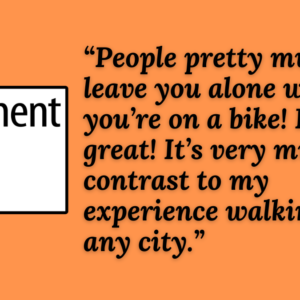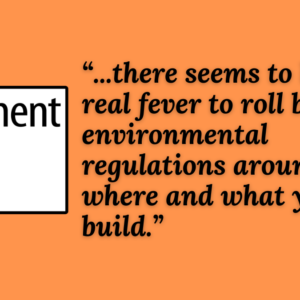Has everyone else been enjoying the week of guest posts? I have, and I noticed that having the variety of authors brought out some new, or at least infrequent, commenters.
One of them was Ilya. (How’s that for dumb luck, maiden comment selected for “Comment of the Week?”) I liked Ilya’s comment into Sarah Risser’s guest post, because they point out something we’ve probably all noticed, but I don’t think I’ve ever seen stated so simply in the BikePortland comments sections.
Don’t we all know that person who drives the kids to school, and then drives to a nearby park to walk a few miles? Here’s how Ilya describes it:
I see people from my block driving to the little shopping strip in Hillsdale, which is about 0.2mi away, to get a cup of coffee or a loaf of bread. It literally takes longer to drive there. This does not comport with the view that it’s a “useful tool.”
I don’t know that I would call it an addiction. It’s more like cars have become the default mode of locomotion. Walking, on the other hand, has become something that people plan for. They carefully plan out the route that they think would be safe. Sometimes, they even drive to places where they can walk. It’s fundamentally a different way of life. What can be done to change this paradigm?
Thank you Ilya. I’ve always experienced this as an east-coast, west-coast thing, which probably isn’t completely fair. But in the dense, east coast cities where I’ve lived, it’s easy to walk a couple miles a day just going about your business. In the west, for many people, taking a walk often seems to involve driving to a beautiful park. It’s recreational.
You can read Ilya’s comment and what everybody else thought, under the original thread.






Thanks for reading.
BikePortland has served this community with independent community journalism since 2005. We rely on subscriptions from readers like you to survive. Your financial support is vital in keeping this valuable resource alive and well.
Please subscribe today to strengthen and expand our work.
I hardly ever preplan my walks, and I doubt many would give much thought to the .2 mile walk described in the post. More generally, I give far more forethought to driving than walking, and I definitely plan my bike rides more than my car trips.
With my car, I’m usually venturing into areas I am less familiar with, so I can and must rely on Google Maps. Mot much more to think about.
With biking, I am more sensitive to routes, and am more likely to have some info about conditions along the way. I want to avoid hills and bad intersections, and make tradeoffs between length of trip and pleasantness of ride that may depend on the time, weather, and purpose of ride. I also know where Google is likely to steer me astray because my preferences are different than their assumptions.
Also, I have a lot more good route options on a bike, so there’s more options to consider.
I used to walk a lot more than I used to. Rain, snow, or hot temps didn’t stop me.
Once upon a time I walked the 3-mile round trip to get coffee or groceries. Not anymore. My life is too precious to leave it in the hands of the lawless people driving our streets.
It’s pretty much driving full time now except the 2 or 3 times I walk to my post office which is just a few blocks.
You should have been a mail carrier!
Every time I went to Europe, I walked everywhere, everything is just so much closer together, locals design their cities to be walk-friendly, to be visually interesting and stimulating, that one walks without thinking about it (and get huge blisters to prove it.) Some Canadian cities are great to walk in too, but most are like the US.
US cities in contrast are much more spread out, even most cities on the East Coast, with boring square blocks, a boring sameness even in the densest cities, but mostly suburban sprawl, often without sidewalks to walk on, with cars dominating.
What a drag life is.
I have such treasured memories of knowing cities by foot, US cities. Every crack in the sidewalk, the interesting buildings, houses, gardens. My favorite Italian bakeries.
Portland Heights with its hidden staircases and passages. The food cart selling lamb with salt and lemon. “The New Haven Casket Company” chiseled into a stone façade. The familiar pan handler, the doorman who says “hi.” The street performers, (sometimes the same one for decades). That ice cream parlor where all the ballerinas hung out …
Having lived on both coasts, from villages with more cows than people to cities, it is all about density and not an east/west thing at all. If it is easier to walk than to drive *for most trips*, people walk. It has to be easy to walk (or walk+transit) to almost everything, and not just easy for that one thing you do every other month. Otherwise car use just becomes habitual.
I had a similar but inverse experience to the author where I thought the west coast had a much more active and healthy lifestyle when I visited for the first time. But actually it seems that cities (e.g. SF) just have a lot more physically active people. I think there is a culture+class nexus, but mostly it’s down to environment.
In Portland specifically, because so much is essentially annexed suburbs with suburban or worse than suburban density and services, it isn’t surprising that people don’t walk in many neighborhoods. I see plenty of people walking downtown – I myself walk as my primary mode of transport. But I have everything I could ever want in walking distance or worst case a short MAX or bus ride.
Its probably time for Portlanders to have a conversation about how strange it is that we have so many SFHs at basically suburban density while facing down a housing crisis.
Agreed, its a density thing, Portland, if you cut out the parks is 5-8,000 people per square mile. It doesn’t lend itself to walking other than for pleasure. (Central Amsterdam is probably 25,000, NYC more, Asian cities 60-100,000)
Actually in the areas closer to 8,000 people/mile (Lents, FoPo, Buckman) there are a decent amount of people walking. Alot of people have stopped because of safety concerns.
I left Portland, thats a different story, but I used to walk all the time for errands, I’d walk to Lents Fred Meyer to shop, after that closed, I’d have to go a bit further, across Lents Park to Walmart, (before it too closed), get groceries and walk back to my house.
I’m fit though, carrying two bags of groceries back one mile isn’t something most Americans are in shape to do. Not to mention the 1.3-1.5 hours the whole thing took.
If, say I also wanted to hit up Home Depot, I’d need to walk back from Walmart, then take the Max down to Johnson Creek and, well it eats up alot of time.
I had no little ones demanding my time, and rarely had a significant other doing the same.
I agree driving 0.2 miles to the coffee shop is pretty lazy and ridiculous. Although could there be mitigating circumstances? Perhaps this is not an able-bodied person, someone elderly, or a young mother that will be attending another errand afterward that requires driving? How was the weather, while walking is ideal, in Hillsdale area i could understand apprehension to gear up if it’s dumping rain and 40 degrees outside.
I’m glad to live on the east side, where walking to parks, transit and coffee shops is far easier than on the west side of town. There is room for improvement, to be sure, including restoring/widening sidewalks, adding ramps to more corners and creating larger sidewalk buffers at more transit stops. It does get harder to navigate the city on foot the farther east you go, and I’d love to see more walk-friendly infrastructure improvements east of 60th Avenue. But along with that, we need more support for park maintenance, schools and subsidies for small businesses to flourish. A return to a more human-scale neighborhoods in cities is possible with focusing on carefully-planned density.
(It’s not possible to have all the amenities close at hand and also have a 1/4-acre property with countryside calm. If you want wide open spaces, better to move out of the city.)
Hi Beth,
Your comment about “1/4 acre” and “countryside calm” reminded me of a quip I frequently made a few years ago: “If I’m close enough to downtown that I can hear the flash-bangs from bed every night, I ought to at least have some bus service.”
Ilya comments that the fact that people drive for trips that could be completed faster on foot “does not comport” with the notion that cars are a useful tool. I would like to examine this statement a little. I bike for many trips that would be faster if I drove, but I still think my bike is a ‘useful tool’ for transportation. Believe it or not, people drive because they like it, and some will accept some tradeoffs to drive, just as I will spend more time on a trip so that I can bike, which is much more enjoyable. As alternative transportation activists, I think we need to acknowledge this state of affairs as a practical matter.
Ours is a driving culture. Even in PDX. Even in NYC. Driving is deeply entwined in daily life and identity for almost all adult Americans. To make political progress for urgently needed reforms that will move us from single occupancy auto dependency we will need support from a large number of habitual drivers. They are not bad people because they drive, and shaming them is counterproductive. For many people, their car is the most comfortable place they can be. They are in charge there, they are safe there, their favorite music is always available, and their personality is reflected in the model and accessories that they have chosen. For many people, their personal vehicle is the only place they feel empowered. Cagers are not bad people, and we need the more persuadable ones to join our political alliance if we want a survivable future. I understand the deep destruction that autos have and are causing both in environmental and human terms. But the drivers deserve empathy, not derision.
You make some good points, but I have to push back on “For many people, their car is the most comfortable place they can be.” In abstract, maybe, but the actual experience of driving tends to make people miserable.
Also your use of the divisive word “cagers” is very incongruous with the whole rest of your comment.
Thanks for your response, Matt. Point taken about the miserable nature of driving. I used ‘cagers’ intentionally as a way to signal a viewpoint that many BP commenters share (i.e. that the current prevalence of autos negatively affects our community). My hope was that the incongruity that you point out would lead to reflection about how to conduct intergroup communications about shared space. Seems like it got you thinking, so yay!
There’s less to the decision for many to drive than meets the eye — that’s just how people get around.
When I lived in a condo, people would respond incredulously with, “You sure” when I politely turned down offers for a ride to meetings which were just across the street with a signaled crossword– closer than plenty of spots in the parking lot. Driving distances of a couple blocks or less is amazingly common.
For this to change, walking needs to not be a thing, statement, or whatever– it just needs to be what people do like driving is. Portraying it as dangerous– which it is not — does not help.